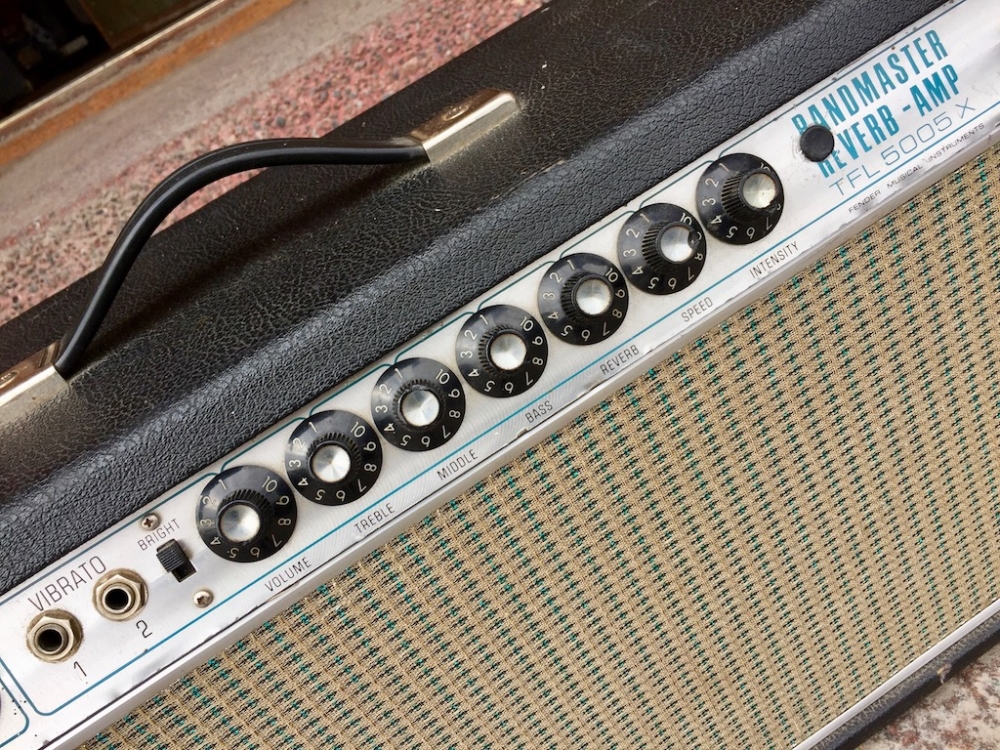



The circuit and cosmetic changes didn't happen at the same time some 1967 and early 1968 Bandmasters still possessed the blackface AB763 circuitry. It is referred to at times as the " silverface" circuit, referring to the brushed aluminum control plate used from 1968 to 1974.

The AA568 version (introduced May, 1968) was met with popular dislike by Fender's customers. Later "silverface" amps retrofitted to this circuitry are described as having been "blackfaced," a reference to the black faceplate used on these amps during much of this era. Some 1964 blackface Showmen were still covered in blonde Tolex rather than the usual black. The complex brownface "harmonic vibrato", however, was replaced by a simpler electro-optic oscillator. The AA763 (July 1963) and improved AB763 (March 1964) ("blackface") circuit is arguably considered the "best" circuit version produced for this amp by collectors and aficionados. The new model was covered in Tolex rather than "tweed " still a combo in brown Tolex for 1960, and then a blonde-covered head-and-cab piggyback 1961-63. The 6G7 and revised 7-A circuit used the long-tail pair phase inverter introduced with the 1957 Bassman, used a solid-state rather than a tube rectifier, and also included a vibrato that is heralded as Fender's best by many enthusiasts. "Blonde" aficionados feel this circuit has superior tonal characteristics when overdriven, to the AB763 circuit. The circuit was used from 1960 until July 1963 when the "AB763" circuit was introduced. The 6G(n) ("brownface") circuit was used in several Fender amplifiers, including the Bandmaster. Phase inverter changed to cathodyne (concertina) type. Negative feedback and filter choke added, and the output section given fixed (grid) rather than cathode bias. the 6SC7, to nine-pin mini-tubes of the 12A(n)7 family, as well as the introduction of the floating-paraphase inverter. The D-series circuits represented Fender's shift from octal preamp tubes, e.g. Like the other larger Fender amps, the Bandmaster used cathode-biased 6L6G output tubes, a 6SC7 paraphase inverter, and two more 6SC7s in the preamp with a 5U4 rectifier.
#1969 BANDMASTER REVERB PRO#
The first Bandmaster was in all respects almost identical to the Fender Pro, a dual-6L6 26-watt amp with a 1x15 speaker, with one difference: separate treble and bass controls, where the Pro like all other Fender amps to that time only had a single "Tone" knob. Transition models had this period features with smooth blonde tolex covering/sparkle gold grille Let me know.6G7-A Feb 1961-1962: Oxblood grille 1962-July 1963 gold wheat grille
#1969 BANDMASTER REVERB DRIVER#
Tubes: A USA 5AR4 rectifier (unable to read the brand), 2- Electro-Harmonix 6L6GC power, a Fender branded 12AT7 reverb driver, 1- Fender, 1- Electro-Harmonix and 3 new Tung-Sol 12AX7 preamp and driver tubes. There is a plugged hole in the back of the chassis that is marked "pre-amp out", so this may have had a modification in its past life but, if so, was removed before I owned the amp. It looks like 3 tube shields have also been replaced. The original cord, tank and switch will be included. Also, the power cord, reverb tank and the reverb switch in the footswitch have been replaced. Comes with the original 2-button footswitch.All electrolytic caps have been replaced. The chassis is very clean and the "drip-edge" cabinet is in great shape. Recently serviced 1969 Fender Bandmaster Reverb TFL 50050.


 0 kommentar(er)
0 kommentar(er)
